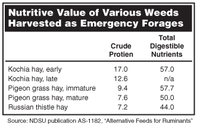Some Weeds Can Be Used As Emergency Forage Crop
(Click the image below to view a high-resolution image that can be downloaded)
This year’s drought conditions in western North Dakota and eastern Montana have producers evaluating alternative forages they normally wouldn’t think of feeding their cow herd.
Russian thistle, pigeon grass and kochia are some plants normally considered weeds that can be used as a source of emergency forage, according to Greg Lardy, North Dakota State University Extension Service beef cattle specialist and associate professor in the Animal Sciences Department.
The best time to cut Russian thistles for hay is when they are in bloom, before the spines form or harden, Lardy says. Hay from thistles cut after the spines harden has very little feeding value and may prove harmful due to the irritation from the sharp spines.
Russian thistles, cut in the blossom stage and carefully cured as hay, contain about the same amounts of protein as alfalfa. The total digestible nutrients (TDN) typically are 10 percent to 15 percent less than in alfalfa hay. Russian thistles also contain about twice as much ash as alfalfa or prairie hay, which results in the Russian thistle hay having a laxative effect.
Lardy has these tips for feeding thistles:
- Do not feed Russian thistle hay as the only roughage. Blend it with other hays or silages.
- Limit Russian thistle hay to one-third or one-half of the roughage in the ration.
- Due to the laxative effect, feed Russian thistle hay with nonlaxative feeds, such as straw, corn silage or prairie hay.
Management skills used to produce good quality alfalfa should be adequate to produce good quality kochia hay, Lardy says. Kochia’s long, narrow leaves are resistant to shattering in the haying operation. Kochia also can be harvested as a silage crop. Producers should follow good silage-making practices (for example, maintaining an anaerobic environment, harvesting at the proper moisture) to ensure good silage quality with kochia.
Kochia hay is similar in nutritive value to alfalfa hay, but it has higher ash content than alfalfa. Ideally, kochia should be cut for hay or silage when it’s 20 to 26 inches tall and before it has produced seed. Protein content ranges from 11 percent to 22 percent, while yield ranges from 1 to 3 tons of hay per acre.
Pigeon grass has a forage value similar to millet when harvested before maturity. When mature, it is relatively low in energy and protein. Pigeon grass can be difficult to windrow and harvest due to its relatively short growing height.
One disadvantage of using kochia, Russian thistle and pigeon grass as forage is they accumulate nitrate. Ruminant animals, such as cattle and sheep, are susceptible to nitrate poisoning because their digestive process converts nitrate to nitrite, which in turn is converted to ammonia. Lardy urges producers to be sure to have these forages tested for nitrates before feeding them to livestock.
For more information, see these NDSU publications: http://www.ag.ndsu.edu/pubs/ansci/livestoc/v839.pdf and http://www.ag.ndsu.edu/pubs/plantsci/hay/a125w.htm.
NDSU Agriculture Communication
| Source: | Greg Lardy, (701) 231-7660, gregory.lardy@ndsu.edu |
|---|---|
| Editor: | Ellen Crawford, (701) 231-5391, ellen.crawford@ndsu.edu |


